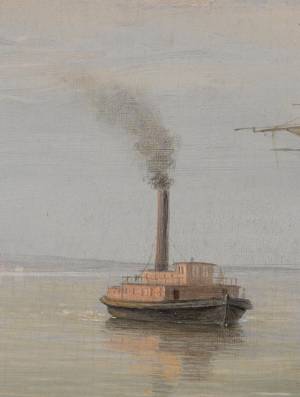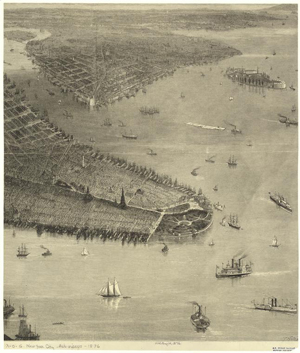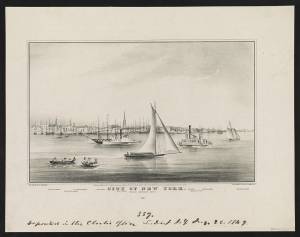An online project under the direction of the CAPE ANN MUSEUM
Tow Boat / Tug Boat
View related Fitz Henry Lane catalog entries (8) »
Tug boat is a general term for vessels of a variety of sizes designed to tow and push large vessels into and out of harbor berths, through confined waterways, and undertake towing and salvage work in deep water. Tugs designed for towing large vessels over long ocean routes are called tow boats, and are larger and more powerful than their harbor-based counterparts.
Throughout the nineteenth century, tug boats were powered with a variety of steam reciprocating engines, the "cross-head" and "walking beam" types being suitable for the early vessels driven by paddle wheels and used in protected harbors. The introduction of the screw propeller and more compact compound engines, made tug boats less susceptible to damage when used in open ocean, leading to the development of tow boats. (1)
New York Harbor was the first American seaport to make extensive use of harbor tugs, due to the size of New York Bay and anchorages therein. A multitude of wharves along the shorelines of Manhattan, Brooklyn, and the New Jersey side (not to mention river traffic from points north on the Hudson River and barge traffic from the Delaware and Hudson Canal) all contributed to a demand for their services. (2)
Boston Harbor, by contrast, was much smaller, with its wharves confined to a compact waterfront. Here, it was easier to move a vessel by warping it from pierhead to pierhead than to use a tug boat for such short-distance work. Even with expansion of the waterfront in the late nineteenth century, Boston had a far smaller harbor tug fleet than New York. (3)
What Boston did need were a few large tow boats for coastwise work. Most large shipyards north of Cape Cod needed tow boat services for sending the ships they built to southern ports for fitting-out. New York had a particular need for this service so vessels built in other yards (including Boston's) could be towed to it for completion (including sails, boats, cabin finish work, marine hardware, and sometimes even masts and rigging). Boston's proximity to New England shipyards made it the logical place to operate a towing service, and Robert Bennet Forbes was one of the first to act on this opportunity. An iron-hull, screw-propelled tow boat was built to his specifications in 1846 for Boston underwriters, who named it in his honor. (4)
– Erik Ronnberg
References:
1. Steven Lang and Peter H. Spectre, On the Hawser: A Tugboat Album (Camden, ME: Down East Books, 1980), xi–xii, 2–5.
2. Harry Johnson and Frederick S. Lightfoot, Maritime New York in Nineteenth-Century Photographs (New York: Dover Publications, Inc., 1980), ix–xii, 3, 7–8.
3. W.H. Bunting, Portrait of a Port: Boston, 1852–1914 (Boston: Belknap Press, 1977), 150.
4. Forbes, Robert Bennet, Personal Reminiscences (Boston: Little, Brown, & Co., 1892), listing of iron steam tug R.B. Forbes in appended "List of Vessels."
Related tables: "R. B. Forbes" (Tow Boat) »
15 1/2 x 13 1/2 in
New York Public Library
Barcode number 33333159142682
Also filed under: New York Harbor »
Lithograph
Published by N. Currier, New York
Also filed under: Currier (& Ives) – New York » // New York Harbor » // Trinity Church »


